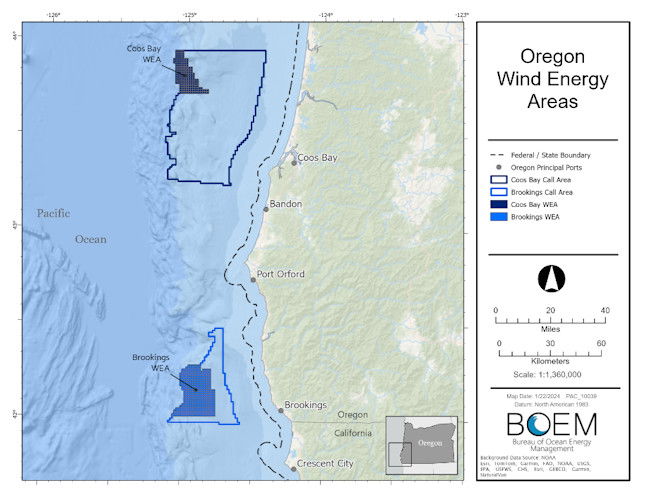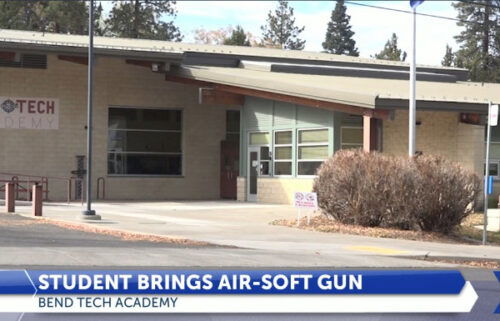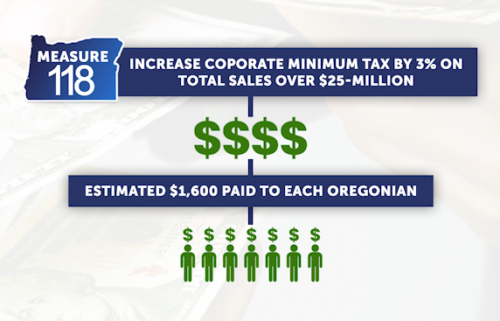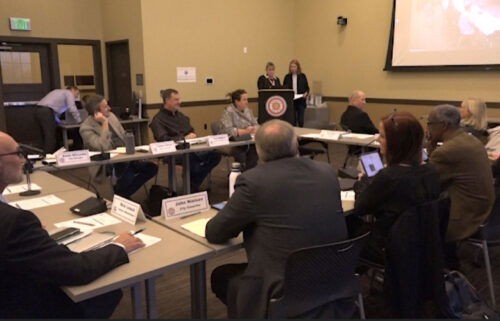Feds finalize areas for floating offshore wind farms along Oregon coast

(Update: Adding AP story, tribal criticism)
PORTLAND, Ore. (AP) — The federal government has finalized two areas for floating offshore wind farms along the Oregon coast, authorities announced Tuesday, bringing the state closer to commercially developing and producing a renewable energy source that's part of the fight against climate change.
The two zones cover roughly 195,000 acres and are both located in southern Oregon, the Bureau of Ocean Energy Management said. One area is 32 miles (52 kilometers) off the coast of Coos Bay, and the other is 18 miles (29 kilometers) from the shore of the small city of Brookings, located near the California state line. They have the capacity for producing 2.4 gigawatts of energy, the agency said, enough to power roughly 800,000 homes.
Following the announcement, Oregon Gov. Tina Kotek said she was committed to developing a transparent roadmap for exploring offshore wind opportunities with the input of coastal and tribal communities.
“Offshore wind is likely to play an important role in meeting our state’s growing energy demand and goal of 100% renewable energy by 2040,” Kotek said in a statement. “It also presents a significant economic development opportunity for the Oregon coast.”
BOEM said it finalized the two areas after consulting with local tribes. But the Confederated Tribes of the Coos, Lower Umpqua, and Siuslaw Indians refuted this, saying they were “extremely disappointed” that areas of cultural and historic significance were identified for offshore wind.
“BOEM’s press release states that it has ‘engaged’ with the Tribe, but that engagement has amounted to listening to the Tribe’s concerns and ignoring them and providing promises that they may be dealt with at some later stage of the process,” Tribal Council Chair Brad Kneaper said in a statement.
As a next step, BOEM said it will prepare an environmental assessment on the potential impacts of leasing offshore wind farms. There will be at least one 30-day comment period to allow the public to weigh in. An additional public comment period may be held if the federal agency decides to move forward with a lease sale in either of the areas.
The offshore wind industry in the U.S. is growing after lagging behind Europe for decades. In December, a turbine off the coast of New York sent electricity to the U.S. grid for the first time. The first auction of leases to develop commercial-scale floating farms was held in 2022, for five sites off the coast of California.
President Joe Biden hopes to deploy up to 15 gigawatts of electricity through floating sites by 2035, enough to power 5 million homes. The administration has set a goal of 30 gigawatts of offshore wind energy by 2030 using traditional technology that secures wind turbines to the ocean floor.
--
Bureau of Ocean Energy Management news release:
WASHINGTON (KTVZ) -- In support of the Biden-Harris administration’s goals for deploying 30 gigawatts of offshore wind energy capacity by 2030 and 15 GW of floating offshore wind energy capacity by 2035, the US Bureau of Ocean Energy Management announced Tuesday the designation of two final Wind Energy Areas offshore Oregon.
The WEAs were developed following extensive engagement and feedback from the state, Tribes, local residents, ocean users, federal government partners, and other members of the public. The final WEAs are based on reducing potential conflicts of ocean users, particularly on commercial fishing.
The two WEAs total approximately 195,012 acres, and they avoid 98% of the areas recommended for exclusion due to their importance as commercial fishing grounds. The Coos Bay WEA is 61,204 acres and is located 32 miles from shore. The Brookings WEA is 133,808 acres and is about 18 miles from shore. A map of the final WEAs can be found on BOEM’s website.
“BOEM values its close coordination with the State of Oregon as we continue to work together to maintain a robust and transparent offshore wind planning process,” said BOEM Director Elizabeth Klein. “We will continue to work closely with Tribal governments, federal and state government agencies, ocean users, coastal communities and all interested stakeholders as we move forward with our environmental review.”
On Feb. 14, BOEM will publish a notice in the Federal Register announcing its intent to prepare an environmental assessment of potential impacts from offshore wind leasing in the WEAs. The notice will initiate a 30-day public comment period. Another public comment period would occur if BOEM decides to move forward with a lease sale in either of the WEAs.
In addition to engaging with the State, Tribes, coastal communities and ocean users, BOEM partnered with the National Oceanic and Atmospheric Administration’s National Centers for Coastal Ocean Science (NCCOS) to assess opportunities for wind energy development and reduce or avoid impacts on other important ocean uses in Oregon.
The agencies developed a comprehensive, ecosystem-based ocean planning model that leverages the best available data on natural resources, ocean industries like fisheries and energy production, and areas of national security activities to identify areas with high wind energy resource potential and fewer potential impacts to other ocean users and sensitive environmental resources.
This comprehensive approach provided valuable insights about the seascape and its uses and facilitated greater transparency and positive coordination with government partners and ocean stakeholders through direct engagement and incorporation of their feedback into the NCCOS model.
On Aug.15, 2023, BOEM announced a public comment period on two draft WEAs located offshore southern Oregon. The draft WEAs covered approximately 219,568 acres, with their closest points to land ranging from approximately 18 – 32 miles. The draft WEAs represented a subset of the original 1,159,298 acres (1,811 square miles) that the Department of the Interior identified for public comment in April 2022.
Since the start of the Biden-Harris administration, the Department of the Interior has approved the nation's first six commercial-scale offshore wind energy projects. BOEM has held four offshore wind lease auctions, which have brought in almost $5.5 billion in high bids, including a record-breaking sale offshore New York and New Jersey and the first-ever sales offshore the Pacific and Gulf of Mexico coasts.
BOEM is exploring additional opportunities for offshore wind energy development in the U.S., including in the Gulf of Maine and the U.S. Central Atlantic coast. The Department also continues to take steps to evolve its approach to offshore wind to drive towards union-built projects and a domestic-based supply chain.
For more information about Oregon activities, visit BOEM’s website.
--
Governor Kotek Issues Statement in Response to BOEM Wind Energy Areas Announcement
Salem, OR — Today, Governor Tina Kotek issued a statement in response to an announcement from the Bureau of Ocean Energy Management (BOEM) on their proposed final wind energy areas on the Oregon Coast for offshore wind:
“Offshore wind is likely to play an important role in meeting our state’s growing energy demand and goal of 100% renewable energy by 2040,” Governor Kotek said. “It also presents a significant economic development opportunity for the Oregon coast.
"As BOEM moves forward with establishing a federal offshore wind leasing process this year, Oregon is committed to developing a robust and transparent state roadmap to inform offshore wind opportunities. This state roadmap will also ensure that coastal communities and Tribal nations are consulted throughout the process, in close coordination with BOEM.
“We will continue to promote active engagement with Tribal nations, local communities, and other ocean users in the state. We will ensure that all decisions are transparent and based upon the best available science and knowledge.”
On February 14, BOEM will publish a notice in the Federal Register announcing its intent to prepare an environmental assessment of potential impacts from offshore wind leasing in the Wind Energy Areas (WEAs). The notice will initiate a 30-day public comment period. Another public comment period would occur if BOEM decides to move forward with a lease sale in either of the WEAs.



